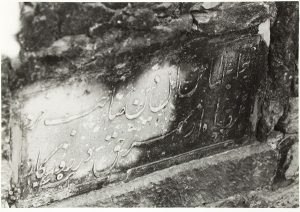IX. The Lotus Garden: Part 3


In this article
Babur’s Legacy

Babur created innovative gardens at each end of the great sandstone ridge, the Lotus Garden at Dholpur and the Bagh-i-Fath (Garden of Victory) at Sikri. Forty years later when his grandson Akbar built his new capital, the City of Victory, at Sikri, he not only adapted the location and name used by his grandfather, he also adopted Babur’s unique layout for his palace. At Fatehpur Sikri, the same narrow watercourse that runs through Babur’s Lotus Garden retreat, links Akbar’s palace buildings. Akbar’s visit to the Lotus Garden was marked by a new well with a plaque bearing a Persian inscription (fig. 2); the visit obviously made a great impression on him.Almost seventy years later Akbar’s grandson Shah Jahan adopted the design for his private palace apartments in his new Red Fort in Delhi. For the fort’s magnificent walls, Shah Jahan used red Dholpur stone, but he preferred gleaming white marble for the riverfront pavilions and the River of Paradise, the watercourse that joins them.
Before Babur created the Lotus Garden, most Indian palaces consisted of small, interlinked rooms, often around a central court, in an enclosed defensive structure. Babur’s original style of open, airy structures was enlivened by the silvery ribbon of water winding through them. The central terrace, where his personal quarters overlooked the lotus pools, was oriented to the north, so it was shady in the afternoon, offering a chance to catch any breeze. Babur describes the surrounding area as “thick with trees, mangoes, jāman (Eugenia jambolana), all sorts of trees.” (Baburnama, f. 339b; translated by Beveridge, p. 606)
In her description of Akbar’s Diwan-i-Khas at Fatehpur Sikri, Mrs. Stuart commented on a miniature painting of Akbar as a young emperor seated on a garden throne: “some such charming retreat in one of his grandfather Babar’s northern gardens most probably suggested Akbar’s novel treatment of the old idea.” Mrs. Stuart cites several examples of Akbar emulating his grandfather, and if she had seen the Lotus Garden, she would have had another significant reference. While documenting the garden I often thought of Constance Villiers-Stuart and how much she would have appreciated Babur’s celebration of the lotus. Throughout her book, she mentions the native Indian lotus as flower and symbol, and when referring to the travels of ancient monks and those of Aurel Stein, she always stated, “Among the flowers, the lotus comes first.”

In her research on ancient Indian garden craft and symbolism, she conveyed the importance of the Indian lotus to religious rituals in her graceful prose. Her discriminating eye would have been charmed by the life of the lotus Babur created in his sequence of rock-cut pools.
Mrs. Stuart spent hot summer months in Kashmir writing about the lotus:
What the mihrab, Allah as a spirit, invisible, intangible, is to the Mohammedans, the Cross of Redemption is to the Christians, the Lotus is to the Buddhist and Hindu. A lotus floating on the cosmic waters is the symbol of the creation of the world. Three species of the flower grow in India: the Nymphaea lotus, the white lotus of ancient Egypt; the Nymphaea caerulea, the blue species; and the Nelumbium speciosum [Nelumbo nucifera], the rose-colored or sacred lotus of India.… Each colour is sacred to one aspect of the Trinity: the rose-petaled lotus—that of the Dal Lake—is the flower of sunrise, Brahma’s prayer; the blue flower is sacred to Vishnu, upholder of the blue noontide universe; the white lotus of evening is the flower of death and resurrection, the emblem of Siva, the Destroyer and Preserver.
Her description of crossing Dal Lake is beautiful and memorable:
Then forcing the light shikara [houseboat] through the sweeping freshness of the large leaves until the boat is almost lost among them, wait till the sun wakes the lotus buds of Brahma. As their rose-dyed petal tips disclose the golden heart you will know why “aum [om] mani padme hum” (Hail, Lord Creator! the Jewel is in the Lotus!) is the oldest and most sacred prayer in India.
Had she seen the long-forgotten Lotus Garden, surely Mrs. Stuart would have been delighted by Babur’s concept. She would have been impressed by the vision of the medieval Central Asian warrior she described as the prince of gardeners and “the most romantic, gallant, genial Prince of Oriental history.”

